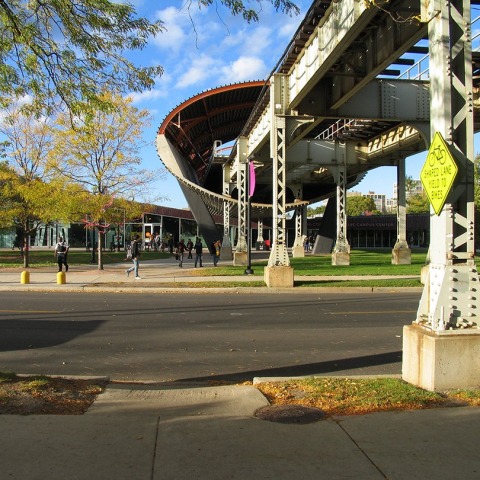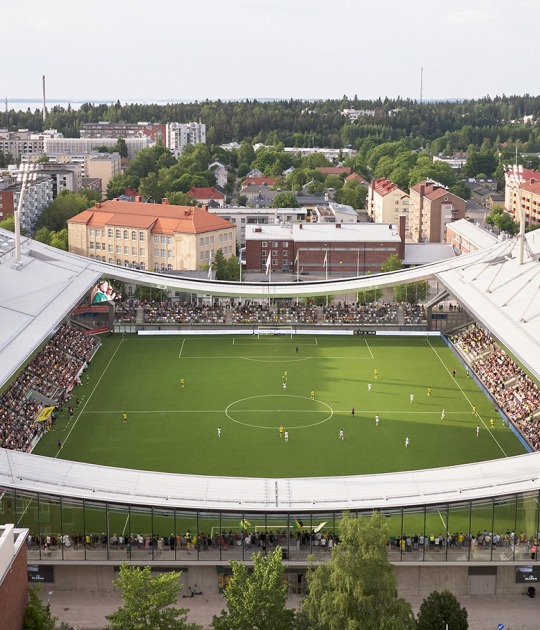OMA designed the McCormick Tribune Campus Center based on the diagonals that IIT students drew on their way across the university campus. Instead of organizing the different activities in a multistory building, the program was allocated in a single level to concentrate all activities together and create a hub for the campus. The result is a horizontal plate with an inner network of streets, plazas and urban islands that form a dense fabric with a high level of activity and different areas according to the different uses: 24 hours, shopping, entertainment, academic, leisure, etc.
Description of project by OMA
The McCormick Tribune Campus Center seeked to reinvigorate the urbanism inherent – but long since neglected – in Mies van der Rohe's 1940 masterplan for the Illinois Institute of Technology. The large single-storey Campus Center provides a focal point for the previously sundered halves of the campus, and features a noise-absorbing steel tube wrapping the Elevated metro that runs directly over the building and, inside, a dense mosaic of programs including a bookstore, food court, café, auditorium, computer centre, and meeting spaces.
How to energize a campus that has half the population that animated it in the 1940s but now double its original footprint? To us, the conundrum implied a building that is able to re-urbanize the largest possible area using the least amount of built substance.
To create a new point of density for the campus, we located the building at the heart of IIT – a large rectangle between State and Wabash, 32nd and 33rd streets – and directly underneath the "L", the artery that connects the campus to the rest of Chicago. By enclosing the tracks above the Campus Center in a muffling stainless steel cylinder, a formerly deafening no man's land becomes a not only tolerable but a magnetic environment. The encircled track – known among students spontaneously as the Tube – becomes a crucial part of the Campus Center's, and IIT's, image.
Rather than stacking activities in a multi-storey building, we opted to arrange each programmatic element of the Campus Center in a dense single plane that would foster an urban condition. To achieve this, in 1997 OMA carried out a study to map the “desire lines” of student foot traffic across the campus. These intersecting diagonal paths are maintained inside the Campus Center itself, linking the multiplicity of activities via a network of interior streets, plazas, and urban islands that form neighborhoods: 24-hour, commercial, entertainment, academic, recreation, and other urban elements in microcosm.
The unifying element of the Campus Center is the roof: a sloping concrete slab that protects against the noise of the L while encompassing the heterogenous programs below. Where the roof ducks beneath the "L", the underside of the the Tube juts through the concrete as a reminder of what's above. The roof has a long overhang that embraces the adjacent Commons Hall, Mies's original student centre, designed in 1953. The Commons has its original perimeter and interior wooden partitions preserved, and now functions as a food court.
CREDITS.-
Architect.- Rem Koolhaas. OMA.
Project Manager.- Jonilla Dorsten, Dan Wood.
Team.- Sarah Dun, Anne Filson, Jeffrey Johnson, Kristina Manis, Gary Bates, Frans Blok, Gro Bonesmo, Eliot Bu, Becca Dudley, Martin Felsen, Adrianne Fisher, Bruce Fisher, Christina Fuchs, Laura Gilmore, Uwe Herlyn, Matthias Hollwich, Krystyan Keck, Adam Kurdahl, Vanessa de Assis Lamounier, Julien Monfort, Christian Müller, Kate Orff, Matteo Poli, Joshua Prince-Ramus, Fernando Romero, Julien De Smedt, Tuomas Toivonen, Angela van der Zee.
Collaborators.- R+D.- Erik Schotte, Bill Price. Models.- Vincent de Rijk, Bert Karel Deuten, Marc Guinand, Gaspar Libedinsky. Architect of record.- Holabird & Root. Interior architecture.- Han Ying Lee, Michell Dremmer. Structural engineering.- Arup, Huygen Elwako, Holabird & Root. Civil engineering.- Terra Engineering. Construction Manager.- Gilbane Building Company. Systems.- SOM, Fazal Mahmood, Louis Ferrer, Marion Wnuk. Acoustic engineering.- TNO, Kirkegaard + Associates. Telecommunications consultant.- Independent Telecommunications Corp. Landscape design and architecture.- Inside Outside, Peter Lindsay Schaudt, Joe Wahler. Curtains, interior consulting.- Inside Outside. Site Ca Consultant.- Studio Gang Architects. Security consultant.- Sako & Associates.
Client.- Illinois Institute of Technology.
Year.- 1993- 2003.
Location.- 3201 S. State Street, Chicago, US.










































